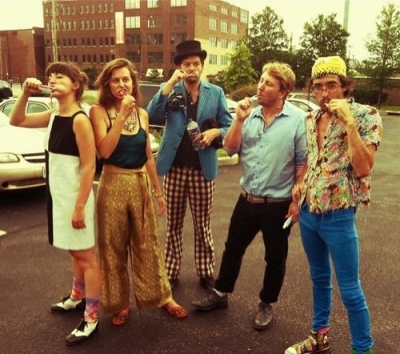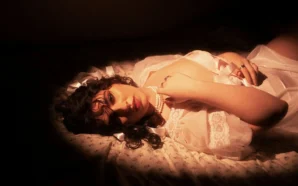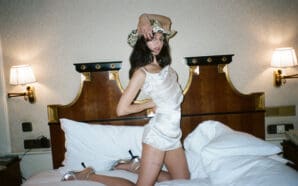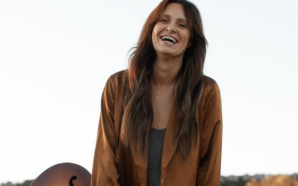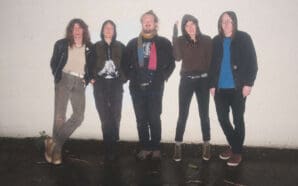A year ago I had a discussion with Los Angeles’ He’s My Brother She’s My Sister about glam rock, Fellini, and Beckett… amidst other things… it was pretty cool. HMBSMS are usually characterized as some combination of traditional folk, 60s psychadelica, and spectacles of glamour… They’re quirky, to put it mildly… They have a tapdancer… At the core of HMBSMS is real-life brother and sister Rob and Rachel Kolar, who are rounded out by Lauren Brown (tap, drums), Oliver Newell (bass, vocals), and Aaron Robinson (lap steel, guitar, vocals). At the time they were on a tour, taking a break from the recording of their debut album. Although they’ve been releasing music since 2010, their first LP, Nobody Dances in This Town, is set to drop January 22nd on Park the Van. In a general sense, the album can be described as a sassy and glittering take on Americana. It’s alt country with a tongue firmly planted in-cheek. It’s Vaudeville, with the knowledge of the traditions of leisurely Western excess that followed. It’s final (and best) track, “Can’t See The Stars,” is “The Night They Drove Old Dixie Down,” through the eyes of a contemporary indie kid… an irony-laden music history buff. I realize these descriptions probably raise more questions than they answer… But I recently got a chance to chat with vocalist, guitarist, kick-drummer Rob Kolar about the current state of HMBSMS… Perhaps he can shed some light…

Izzy Cihak: While Nobody Dances in This Town isn’t your first release, it is your first proper album. How would you characterize it, possibly in comparison to earlier (shorter) releases?
Rob Kolar: Nobody Dances in This Town is a better reflection of our current live show than previous releases. There are raw elements in the drums, bass, and vocals. Most of the tracks were cut off the floor and there really aren’t all that many overdubs. The slide guitar swirls around many of the tracks and there is a lively looseness about the performances. No click track, and it’s the first album with Lauren simultaneously tap dancing and playing the drums. Thom Monahan (producer) was set on capturing the qualities of our live show and we spent some time listening to early punk music for reference and inspiration. X’s first record, produced by Ray Manzarek, was a particular album we spent time with and Thom said it was one of his favorites. Thom relished in his moment, meeting Ray and telling him how much that album meant to him (unlike most fans who praise him for his work with The Doors). I liked that, and appreciate Thom’s meticulous attention to the unpredictable.
IC: What inspired the album’s title?
RK: We were being interviewed and the writer asked if there was something we often heard while traveling on the road. “Nobody Dances in This Town” was the response. Most towns claim to be stiff in the “dancing” department (unless it’s to the generic dance choices you here in clubs), but when we performed, people loosened up and shook their booties. Folks would swing by the merch booth all sweaty and say “That was so fun! Nobody dances in this town!” Felt like an appropriate title for the record.
IC: I noticed in the liner notes (which I always read) that you thank The Blow, so I’m assuming you’re a friend of theirs . I have to know how that relationship came about as, musically, the two of you are super different… and I have the feeling it’s a good story.
RK: We toured with them, one of our first opportunities to hit the road. Was really great because at the time few bands knew who we were, but they were intrigued and took a chance on us. We will always appreciate that. Super nice people and really sweet. Also, very focused in their art. I think they have a fondness for the bizarre and theatrical, so we worked as an opener. We are quite different musically, but it also seemed to make sense for a well-rounded night of entertainment. We have taken that notion with us when deciding on openers and support acts.
IC: What were your highlights of 2012? In addition to recording, you spent quite a bit of time on the road.
RK: Seeing the world spread and people telling their friends in different cities to come and see was really awesome. It meant there were less clubs where we were playing for the bartender and his friends. Playing Austin City Limits with some of my heroes, like Neil Young, Jack White, and James Mercer was also a thrill. And seeing the crowd get up early and rally for our set was fantastic. Austin has quickly become one of our favorite towns to play.
IC: The last time we chatted for Philthy Blog (which is now Philthy Mag) you mentioned a lot of non-musical artists and works of art that you found to be especially inspiring. Did you come across any especially great or noteworthy works in the past year?
RK: I have really been digging a lot of West African sounds of the early 70’s. Hallelujah Chicken Run Band is one of my favorites and I spend a lot of time with their pandora station. I discovered them through a great movie called Submarine. Richard Ayoade (the director) mentioned the band in an interview and I thought I’d take a chance. Glad I did. Spend a lot of time shlepping around LA with them as the soundtrack. I was pleased to see an independently financed film like Beasts of The Southern Wild get so much attention. It’s inspiring to see that it can be done without the pocket books of the studios. Hoping it gets a Best Picture nod too. There are a lot of parallels in the music and film world and seeing that kind of success from an independent force gives us hope and drive to succeed ourselves.
IC: Are there any works of art or artists that had a prominent influence on the writing and recording of NDITT?
RK: A long list. I think the more obvious musical ones range from Eddie Cochran, Tom Waits, Bo Diddley, Johnny Cash, to Jefferson Airplane, Arthur Alexander, The Black Keys, The Mamas & Papas, and T. Rex. I am also very influenced by the chameleon qualities of artists like David Bowie. I admire the work ethic and focus of Stanley Kubrick. Love the humor and absurdity of Monty Python. And the playful eeriness of early Tim Burton films. All of these things play a part in my identity in this band.
IC: What are your plans, hopes, and goals for 2013?
RK: I’d really like to see us reach the next plateau where we can be more creative with our sound and lighting, where the band alone can fully sustain our lives and become our primary career. I think we’d all like to explore what this band is capable of beyond simply being a recording and touring act, incorporate more of our film and theatrical backgrounds and experiment with the medium that is rock & roll and take it somewhere new.
